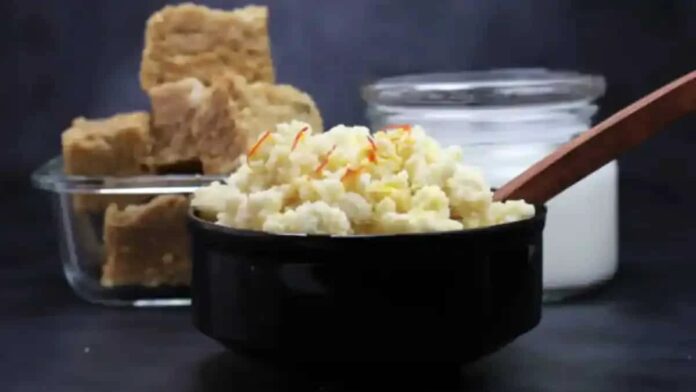Want to elevate your homemade mithai? Simply add khoya! known as mawa, khoya is essentially evaporated milk solids, obtained by simmering milk until most of its moisture evaporates, resulting in a dense, fudgy substance.
This versatile ingredient serves as the base for many delectable, traditional sweets.
Khoya is a dense, fudgy substance with a low moisture content. It doesn’t melt like cheese or butter but softens when heated. Depending on the recipe, you may need to crumble or grate khoya before using it. It has a mild, milky flavour that can serve as a good base for adding sweetness, spices, or other flavourings in desserts. Khoya can be incorporated into recipes by crumbling it directly into the dish, mixing it with other ingredients, or cooking it down to form a thick paste. Here are some homemade desserts that you can elevate with the help of khoya.
Gulab Jamun
Did you know you can easily add khoya to homemade gulab jamuns to enhance their taste and boost their velvety texture? Simply make soft, syrup-soaked dumplings by kneading khoya with flour, shaping them into balls, and deep-frying until golden brown. Immerse them in a fragrant sugar syrup infused with cardamom, rose water, and saffron, letting them soak up the sweetness and aromatic nuts.
Peda
Peda is traditionally crafted from khoya, sugar, and aromatic spices such as cardamom and saffron; they are shaped into small, disc-like rounds and garnished with nuts or edible silver foil. The creamy texture of khoya imparts a smoothness to the peda, while the subtle sweetness and fragrance of the spices elevate its taste.
Barfi
You can make any kind of barfi at home with khoya or mawa and enhance their dense, fudgy consistency. Khoya serves as the primary ingredient in many traditional barfi recipes, contributing to their rich, melt-in-your-mouth texture. Whether flavoured with nuts, fruits, or aromatic spices, it’s easy to highlight their delicate sweetness if you include khoya. delicate sweetness. From classic varieties like kaju barfi (cashew fudge) to innovative creations such as chocolate barfi, these irresistible treats showcase the versatility of khoya.
Kalakand
Kalakand is typically from khoya and paneer and has been cooked down with sugar until thick and creamy. The addition of khoya lends kalakand its signature richness and creaminess, while the paneer contributes a slightly grainy texture that’s a signature of most traditional Indian sweets. Perfumed with cardamom and garnished with nuts, khoya kalakand has a strong nutty essence which makes it a popular choice for festive celebrations.
Malai Peda
Malai peda is a variation of the classic peda made with the addition of malai or clotted cream. Combining khoya, malai, sugar, and aromatic spices, this dessert has a luxuriously creamy texture and a subtle richness that sets it apart from regular peda. The velvety smoothness of khoya and the silky richness of malai come together to create a decadent profile.
Mawa Kachori
Mawa kachori is a deep-fried pastry filled with a delectable mixture of khoya, nuts, and aromatic spices, and soaked in a sugar syrup. This indulgent dessert is a popular Rajasthani number and is often enjoyed during festive occasions and special celebrations. The filling, made from khoya combined with chopped nuts, dried fruits, and fragrant spices such as cardamom and saffron, imparts a rich and aromatic flavour to the kachori.
Shahi Tukda
It’s quite easy to add khoya to this Mughlai dessert. This decadent treat features deep-fried bread slices soaked in a creamy, fragrant syrup made from khoya, sugar, and saffron-infused milk. It’s topped with a generous layer of thickened rabri (sweetened, reduced milk) and garnished with nuts and edible silver foil. The combination of crispy bread, velvety khoya syrup, and creamy rabri is an irresistible medley!


